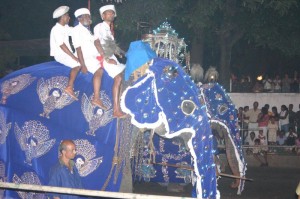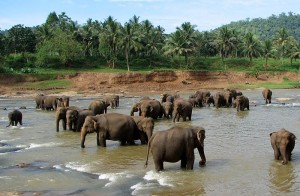Sri Lanka’s pachyderms: What does the elephant survey mean amid calls for boycott of religious pageants
Despite international excitement on the first elephant survey done in Sri Lanka last month (August) local scientists and environmentalists are not happy.
Rajapakse cronies
Sri Lanka’s present government has been particularly remiss in its duty towards the country’s fauna and flora actively supporting the massive destruction of virgin forests and national parks for so-called development projects that have only ended up being personal gold mines for the Rajapakse family and their cronies.
There are 5879 Wild Elephants in Sri Lanka at present according to the latest National Elephant Census Report issued September 2, 2011. According to the report there are 122 Tuskers and 1107 Baby Elephants amongst these Wild Elephants. These numbers too are in dispute with some experts saying there could have been no way the population could have increased to this level during a war that ravaged Sri Lanka’s forests and with so many elephant deaths recorded as well.
Scouring the landscape
Yet why so many activists and environmentalists are concerned is because Temple prelates and government officials have been scouring the landscape looking for baby elephants to participate in temple ceremonies. In fact the National elephant survey some charge was nothing but a front to find baby elephants suitable for religious pageants. Elephants have long been associated with religious and traditional celebrations in Sri Lanka.
The deepest concern among environmentalists and activists was that baby elephants who were torn away from their mothers before the stipulated weaning period suffered terribly, while the mother became distraught and inconsolable.
Babies torn from their mothers
In fact in July 2009 there was an uproar in Sri Lanka with many including several bloggers calling on tourists to boycott the famous Kandy Perehera – an annual religious ceremony involving much pomp and pageantry including colorfully dressed elephants – due to the cruelty with which baby elephants are torn away from their mothers to be taken to Temples and tamed for the purpose. Not only that the elephants must walk miles on scorching asphalt as they partake in these long drawn out processions.
Pinnawela Orphanage
The controversy focused on one of Sri Lanka’s most endearing cites the Elephant Orphanage in Pinnawela in Central Sri Lanka. The two calves were taken from the orphanage by officials and handed over to the Temple of the Tooth in Kandy. It was reported that the Diyawadana Nilame Pradeep Nilanga Dela, the chief custodian of the Temple of the Tooth, forcibly removed the two calves from the Pinnawela elephant orphanage. He took these elephants, who were still feeding on their mother’s milk, despite protest from the officials and veterinarians at the orphanage.
Confined and chained
The forcible removal took hours. The mother was grieving and put through an enormous amount of stress. The vets at Pinnawela made it very clear to everyone that the the babies were too young to be separated from the mother. That, however, didn’t stop Diyawadana Nilame Pradeep Nilanga Dela. The calves were not doing well and had to be confined and chained. The mother was also in grave danger as milk which collects in the female elephant can lead to several health issues if she is not feeding.
Taking mother to calves
government officials were adamant to keep the calves in the temple but had said they would take the mother to the calves.
Animal rights activists, environmentalists and Pinnawela Elephant Orphanage had warned however that taking the mothers to Kandy would lead to problems. Pinnawela officials has said that mothers were semi-wild animals. If they were to be taken out of their surrounding, they had to be either tranquilized or drugged. This would lead to loss of milk.
Shortage of elephants for ceremonies
The government has often said there was a shortage of elephants for religious processions yet environmentalists say that the elephants
were taken from their mother while they were still suckling.
“The mothers’ udders have swollen because they’re unable to give milk. It’s not only the calves but even the mothers that are suffering,” environmental lawyer Jagath Gunawardena told the AFP news agency.
Live with mother for at least 5 years
Animal rights groups say that baby elephants should live with their mothers for at least five years – and that the removal of the calves amounts to cruelty against them. The Sathwa Mithrayo spokeswoman Sagarika Karaunananayake told media that the government’s constitutional requirement to safeguard and develop Buddhism in the island should not be at the expense of rare wild animals.
When the controversy erupted in 2009 Sri Lankan cabinet minister Anura Priyadharshana Yapa explained the reasons for handing them over to the temple. He was quoted as saying the temple, which is the headquarters for some prominent Buddhist monastic chapters, was the centre of a social, cultural and religious renaissance in Sri Lanka.
“There is a severe shortage of tamed elephants which take part in religious processions,” Mr Yapa is quoted by the government’s information department as saying. “The ministry of sports and public recreation decided to gift two baby elephants from Pinnawela elephant orphanage for the purpose.”
Meanwhile Dr.Vijitha Perera, a veterinary surgeon attached to the Department of Wildlife Conservation, has published some shocking
revelations about years of abuse for the sake of the Kandy Perahara in his book, “Ten Years with the Wild Elephants”
“During its seven months in captivity at Mawanella, this elephant never slept. A dip in water to cool the body heat is a common practice of jumbos, but this elephant was taken to the river only three times during its seven-month ‘prison-like’ life. In the wild, he could have walked 15/20 kilometres a day, but not even 100 metres during the time mahouts tried to tame him,” wrote Dr. Perera in his book, as quoted in the local media.
Suffering from wounds caused by chain cuts, the elephant given to the Dalada Maligawa [temple of the tooth] died.
“Knowing what we know today, it would grossly irresponsible of us to patronise this event. There are less than 5000 elephants in Sri Lanka, and every year 150-200 wild elephants die in the wild due to human-elephant conflict. Pinnawela’s release program also appears to be failing. Some claim that all elephants released into the wild by Pinnawela have died. It’s hard to breed elephants in captivity and expect them to fend for themselves in the wild.
Importing elephants
At the rate Sri Lanka is heading, it’s safe to say that in the next 20 years we will be importing elephants for the sake of the Kandy Perahera because we ran out of our own. I would feel ashamed to call myself a Sri Lankan if I am alive to see that day.
Everyone will pamper the interest of the temple over the teaching of Buddha. Don’t confuse Buddhism with the Perehara. Lord Buddha never spoke of a Kandy Perehara, or such cruelty in his name. We shouldn’t either! If you are visiting Sri Lanka, there is a lot more to do than the Kandy Perahera.”
Speak out
Sri Lankans have to stand up and fight against all kinds of cruelty at every level in every degree. We cannot leave it to somebody else anymore. This website published the harrowing tale of the Sloth bear so cruelly treated until a Dutch couple came to its rescue. It published the story of a proposed road through a rain forest designated a World Heritage site demonstrating the hideous disregard Sri Lanka’s government has for its natural resources and its fauna and flora. In a country that prides itself in its Buddhist heritage one sees little evidence of buddhist values practiced in its everyday life. It is the duty of every Sri Lankan to stand up and fight against cruelty and it is the duty of every tourist and every visitor to that resplendent isle to stand up and speak out against the destruction of Sri Lanka’s natural heritage.



April 28, 2012 at 11:38 pm
Very nice post. I just stumbled upon your blog and wanted to say that I have truly enjoyed surfing around your blog posts. After all I’ll be subscribing to your feed and I hope you write again very soon!
February 20, 2012 at 1:27 am
Hi, i think that i saw you visited my web site so i came to “return the favor”.I’m trying to find things to improve my website!I suppose its ok to use some of your ideas!!
October 8, 2011 at 5:35 pm
Thanks for the share!
Hellen